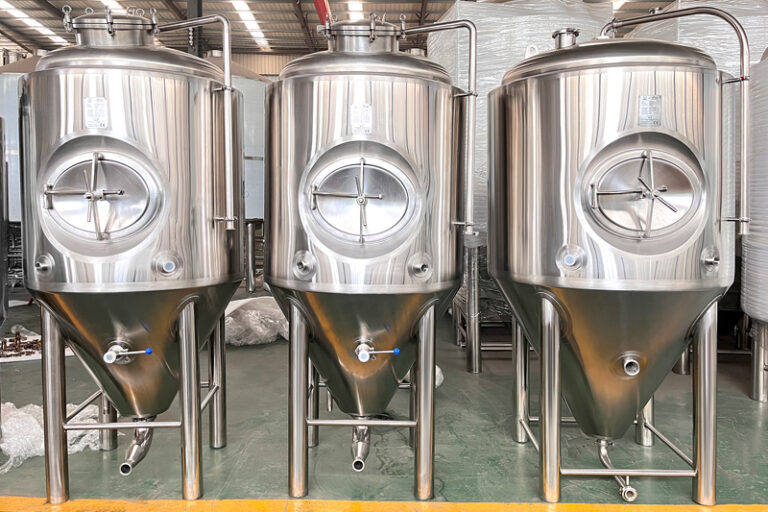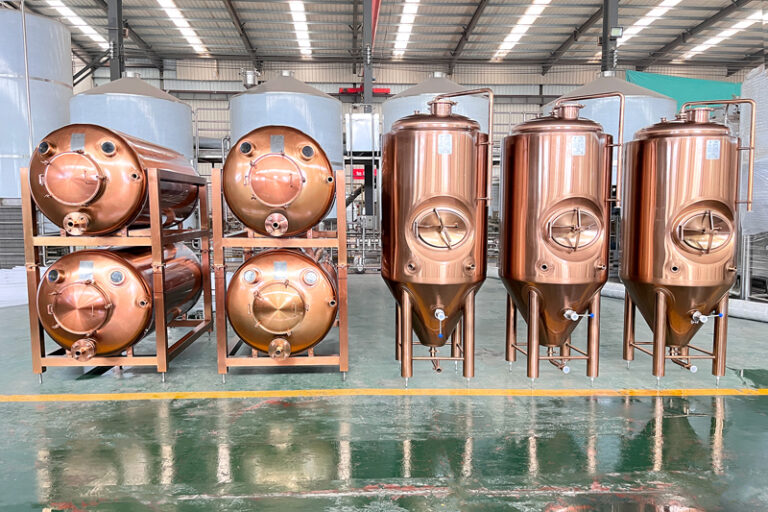In the beer brewing industry, the material of your equipment’s housing is critical to ensuring the quality of your beer, maintaining the hygiene of your equipment, and increasing your productivity. When you visit a brewery you will find different beer equipment housings, generally in two main categories: stainless steel and copper. Stainless steel can be further categorized into 304 stainless steel and 316 stainless steel. Stainless steel and copper are two common materials, each showing unique strengths and weaknesses in brewery equipment.
Table of Contents

Stainless Steel Brewing Equipment
Advantages
- Excellent corrosion resistance: stainless steel is known for its excellent corrosion resistance, which can effectively resist the erosion of acids, alkalis, salts, and other chemicals commonly found in the beer brewing process, thus prolonging the service life of the equipment.
- Easy to clean and maintain: the smooth surface of stainless steel does not easily adhere to dirt and bacteria, which makes the daily cleaning and disinfection of the equipment easy and quick, helping to maintain a high standard of hygiene.
- No impact on beer quality: Stainless steel is stable will not react chemically with the ingredients in the beer, and will not introduce odors or impurities, thus ensuring the purity and flavor of the beer.
- Aesthetics and durability: the stainless steel casing is not only modern but also durable and able to maintain the aesthetic appearance of the equipment for a long period.
Disadvantages
- Relatively high cost: Stainless steel is expensive to produce compared to other materials, which can increase the overall investment in the equipment.
- Average thermal conductivity: although stainless steel has some thermal conductivity, it is not outstanding compared to some metals (such as copper), which may affect to some extent certain brewing processes that require precise temperature control.
Stainless Steel Applications
- Wort Bucket: a vessel in which crushed grains are mixed with water and heated. This process converts the starch in the grain into sugar.
- Fermenters: Stainless steel fermenters are one of the most common pieces of equipment in breweries. They ferment beer ingredients (malt, hops, water, and yeast) and carry out the fermentation process under controlled temperature conditions. Advantages of stainless steel include corrosion resistance, ease of cleaning, and structural strength to withstand high pressures and prolonged use, ensuring hygienic and quality beer.
- Wine Storage Tanks: In breweries, stainless steel wine storage tanks are widely used to store raw materials, fermentation liquids, and finished beer. Stainless steel tanks are also corrosion-resistant, and easy to clean and sanitize, which ensures the quality and hygiene of the beer in the storage process. In addition, stainless steel tanks also have good sealing performance, which can prevent the beer from being contaminated by the outside world during the storage process.
- Piping and fittings: The beer production process requires many piping systems, including the transportation of wort, coolant, and cleaning agents. Stainless steel piping and fittings are widely used for their corrosion resistance and ease of cleaning, which ensures hygiene and safety during fluid transfer.
- Other equipment and components: Including coolers, malt mills, filtration systems, and various other beer production equipment and components, stainless steel is often used to fabricate or clad key components to ensure equipment durability, sanitation, and productivity.

Copper Brewing Equipment
Advantages
- Good Thermal Conductivity: Red copper is known for its excellent thermal conductivity, which helps to evenly distribute and precisely control the temperature during beer fermentation, enhancing the brewing results.
- Traditional aesthetics: The red copper casing gives the equipment a classical and elegant aesthetic, especially favored by some brewers who pursue traditional brewing techniques.
- Possible enhancement of beer flavor: Some brewers believe that red copper can subtly react with the ingredients in beer to add unique layers of flavor. While this effect has not been fully proven in modern science, it still has some appeal.
Disadvantages
- Poor corrosion resistance: although copper is beautiful, its corrosion resistance is relatively poor, and it is easily eroded by chemicals in the beer brewing environment, leading to surface discoloration, oxidation, and even corrosion, which affects the sanitary condition and service life of the equipment.
- High maintenance costs: Since copper is prone to oxidation and corrosion, it requires regular care and maintenance, including polishing, cleaning, and anti-corrosion treatment, which increases the maintenance and time costs of the equipment.
- Potential risk to beer quality: If the copper enclosure is not properly maintained, oxides or corrosion products on its surface may be dislodged and mixed into the beer, adversely affecting beer quality.
NOTE: If a bluish-green color is noticed anywhere on copper brewing equipment, it needs to be thoroughly scrubbed with a vinegar or oxalic acid cleaner. In addition, bleach and hydrogen peroxide will darken copper and will not prevent corrosion.
Conclusion
In brewery equipment, stainless steel is a more universal and suitable material choice. Due to its excellent corrosion resistance, easy cleaning, and structural strength, it can meet most beer manufacturing requirements. Copper can also play an important role in certain specific application scenarios due to its excellent thermal conductivity and unique appearance, but its high cost and easy oxidation characteristics should be noted. Therefore, the specific choice should be considered comprehensively based on factors such as equipment function, budget, and operating environment.

